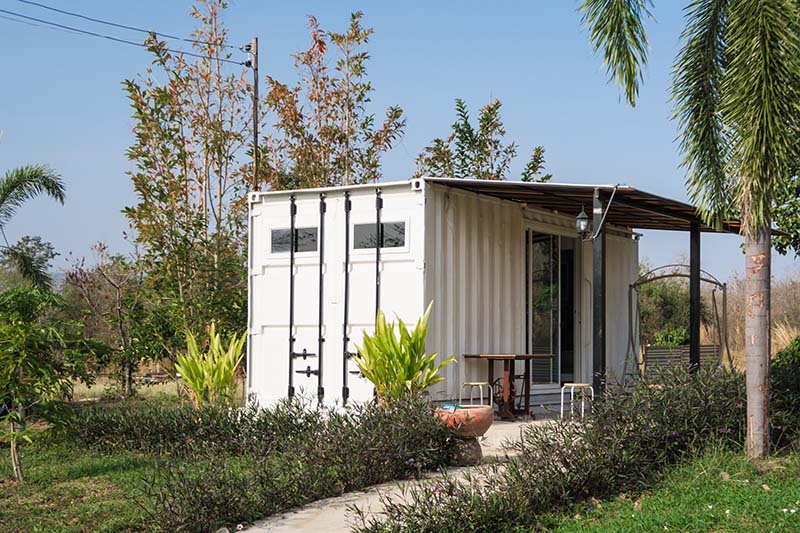Are Shipping Container Homes Legal in Ohio? What To Know!
-
Kristin Hitchcock
- Last updated:

Shipping container homes are legal in Ohio. However, they must still adhere to all building regulations and codes. Therefore, you’ll need to know all these codes before you start building—or hire someone who does. Local building codes do vary from place to place. They aren’t set at the state level, so you’ll typically work with local regulators.
The Ohio code clarifies that the shipping container is considered a “home” as soon as it is made into a dwelling. Once you start putting doors and windows on it, the state no longer considers it a shipping container. Therefore, they don’t consider a shipping container home to be any different from a regular home.
However, you must consider many procedures and permits before building one of these homes. You may not have to do much of this work if you hire a building company specializing in these homes. However, if you want to do some legwork, you’ll have to ensure that you purchase the right permits and follow the correct procedures.
Approval and Permits
Before you build a shipping container home, you’ll need to seek approval from your local Ohio Building Department. You’ll need a complete plan for this to happen. Therefore, you’ll likely need to hire someone to draw up the plan—preferably someone with experience putting together shipping container homes. You can draw up these plans yourself, but this will usually lead to mistakes unless you are a professional. Drawing a correct house plan is more complicated than you may imagine.
Sometimes, your first attempt at approval may be denied. While nothing blatantly makes it illegal to build shipping container homes, they may need to be edited to make them fit building codes. For instance, in some areas, you cannot have metal siding like the outside of a shipping container. Therefore, you must cover it with something else to make it legal.
If your plan gets denied, the office should explain why. Then, you can make the necessary changes or have an engineer do it for you.
Getting a permit can take a long time. It isn’t strange for one of these permits to take up to 4 months for approval, especially if there is a backlog. If you have a building company doing the plans for you, it may not take as long. Often, they know exactly what the state is looking for and are recognized in the department.

Potential Snags
There are several potentially unlawful elements of container homes. Rarely, container homes are outright banned. Because all regulations are made at the local level, you will need to check your local guidelines first and foremost.
While container homes aren’t illegal, some common ways they are built may be unaccepted in some areas. For instance, sometimes, the size of the home is controlled and sometimes, there is a minimum square footage requirement. In this case, one container may not be large enough to count as a “home.” The appearance and materials used for the outside materials and roof may need to be adjusted to make it legal.
The foundation is often regulated, too. Where the storage container is on the property may also be regulated. For instance, it may be a certain distance from the road or edge of the property.
Most areas have fire and smoke regulations, as well. You may have to have a certain number of smoke detectors per square foot or bedroom numbers. Carbon monoxide detectors may also be necessary for some areas, though it often depends on what is inside your house, too.
The home structure may have to hold up a particular amount of snow or wind. While storage containers often don’t have a huge issue, you may find that you need to adjust the structure to make it fit these regulations.
None of these regulations mean that you cannot build a container home. However, they mean that you have to make adjustments to your original plan to get the building approved. You should work with an engineer to determine what changes need to be made. Working with a company can make this process much smoother, as they are often used to building container homes within these necessary regulations.

How Much Does It Cost to Build a Container Home in Ohio?
The cost of the container home depends largely on the size. Some container homes are constructed inside a single container. These are much cheaper on average, as they are much smaller. If you use multiple containers to build your home, you can expect it to cost quite a bit more. You also have to consider what finishings you want, the plot of land you’re building, and your chosen foundation.
Many of these considerations will depend on your personal preference. Others will depend on your local regulations. If your area has zoning laws, you can only build a residential structure in certain places, for instance.
The cost of building a container home is typically around $105 per square foot (not counting land) in Ohio. A traditional home is closer to $138, so there is a bit of saving. However, adding premium finishings or many containers can easily raise the price. Therefore, you should not plan on this project being extremely cheap. Budget appropriately. You are still building a home, and homes are expensive!
Can Container Homes be Insured?
Once your container home is built, nothing separates it from any other home. Therefore, it can be insured. As long as it is built to your local building codes, there is no reason you can’t purchase insurance on your home. In many cases, you can go with a traditional home insurance company. However, there are also several companies out there that specialize in insuring these types of homes. They may even insure the shipping containers while they are being shipped.
Unlike other alternative homes, many companies have no issue with shipping container homes. You may even be able to get traditional financing—unlike other alternative home types. These homes have great fire and safety ratings, which often reduces the odds of claims. Therefore, insurance and financing companies usually don’t have rules against insuring these homes.
Sometimes, you may not even need to tell the company that your home is a container home. As long as it meets your local regulations, it technically isn’t any different from any other home.

Conclusion
Every area has different building regulations. The local building departments set building rules. Therefore, it is vital that you check your local laws, as they vary across Ohio. It is very rare for local governments to ban container homes blatantly. However, there may be a few changes you have to make to your original design to make the building fit local codes.
You can do all of this work yourself. However, it often works best to hire a local expert to help you adjust your plan for the local codes. You can also work with a building company that specializes in these homes. These companies know what needs to be done to meet local regulations, which can make the process much smoother.
Either way, it is legal to build container homes in Ohio. Just be sure that you check local regulations to ensure that your plan is up to code.
Featured Image Credit: Gareth Lowndes, Shutterstock
Contents
